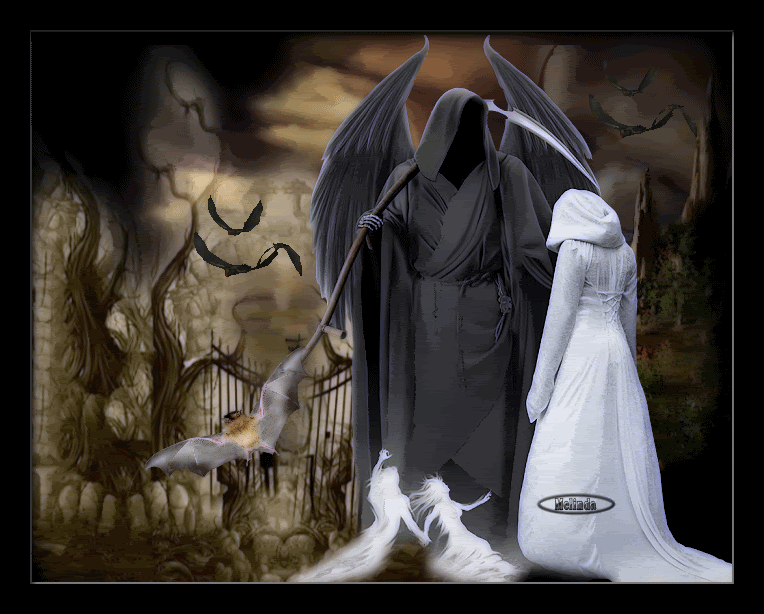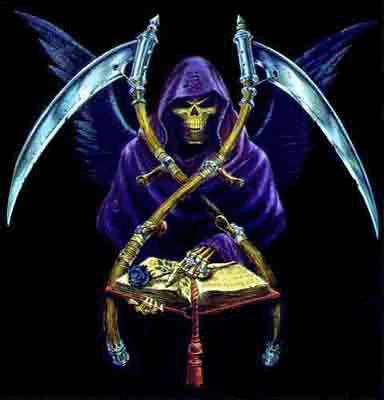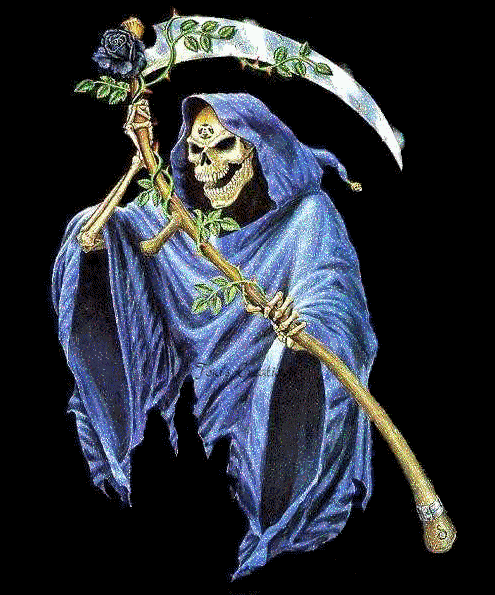|

Because I could not stop for Death,
He kindly stopped for me.
The Carriage held but just ourselves
And Immortality
~Emily Dickinson~


The idea of an angel of death is millennia old. There are references to an angel who delivers the wrath of God in the Bible, Quran, and other religious texts. Over the centuries, the angel of death evolved from a sometimes unseen supernatural force that decimated cities and armies with fire and brimstone from the sky, to a very personal and one-on-one encounter between a black-cloaked skeleton carrying a large scythe and hourglass, and an unlucky person who is about to lose their life.
It was in the 15th century that the Grim Reaper took on the dark, hooded robe persona. The image evolved from the traditional garb of pallbearers at funerals—the dark robe with a bowed head. Artists took the image to a more horrific level by making the person under the robe either a rotting corpse or skeleton.
Soldiers in the battlefield, the elderly in nursing homes, sick people in hospitals, and people from all walks of life have reported seeing a dark, shadowy figure near the scene of death. Beating the death angel is not just the ambition of Dr. Frankenstein; ordinary people have fought to overcome the inevitable that is waiting for us all.
source:
http://www.ghostvillage.com/legends/2002/legends1_09072002.shtml

The grim reaper, a diabolically dark figure has captured the imagination of many people around the world! Was he the answer, that the man found to his questions about the death and dying? This entity features in folklores and movies. Associated with the forces of darkness, the scythe that the Grim Reaper wields symbolizes the harvester or keeper of souls.
The Grim Reaper escorts souls of the deceased to the unknown territory of life after death. While some believe that he arrives on an old coach drawn by white horses, others believe he arrives on a horse without coaches. The skeletal face of Grim Reaper which wears a grin is known to haunt a number of people all across the universe. The information on Grim Reaper - origin and history is presented below which will hopefully make his character "ALIVE" for the readers!

Grim Reaper Origin And History
Many religions believe a particular spirit or deity, is responsible to look after the souls after the death of a person. The Grim Reaper is considered this Psychopomp, who performs his duties of looking after souls of the dead. In ancient
Greek mythology, Charon was such a entity, who carried the souls of the recently deceased in a ferry across the river that separated the world of the living from the dead. Although, some historians depend on the Hades facts, when it comes to the interpretation of the Grim Reaper legend, others believe the entity is a manifestation of one's own belief.

Folklore and Mythology
Odin, who was considered the god in Norse paganism, was considered the leader of souls. His assistants, Valkyries, escorted the dead warriors to their rightful place, a hall in heaven. In Germanic folklore Odin, who rode on a nightmarish horse and wielded a spear had all the characteristics of the ones associated with the Grim Reaper. Some historians also claim that Odin who was also called Grimnir led to the conceptualization of the Grim Reaper.
In Breton mythology the personification of death which was Ankou, donned a long black robe. Legend has it that two horses pulled his cart which helped him carry the souls of the deceased. Although, some believe that the popular entity of the Grim Reaper is derived from the legend of Ankou, others claim it isn't true.
In ancient times Salvic people viewed the manifestation of death as a woman in white robe with the power to put an individual to an everlasting sleep, with the help of an everlasting green sprout in her hand. Later in the middle ages, the theory of death as an entity was portrayed as a walking skeleton.
Baltic ethnic groups in ancient times considered death to be in the form of an ugly old wrinkled woman with a poisonous tongue and a long nose. Later on these theories were dismissed and a skeletal figure became a manifestation of death. Hindu mythology describes the lord of death as Yamraj, a figure that rides a black buffalo and carries the soul of the dead person to Yamlok, his abode.
Although there are different accounts of the manifestation of death, the Grim Reaper has become a conceptual personification of death the world over. The presence of this nightmarish entity has captured the imagination of storytellers, writers and artists.
source:
http://www.buzzle.com/articles/grim-reaper-origin-and-history.html

If you'r e going to give death a human face, why not make it friendly? That was the approach taken by the Greeks, who named death Thanatos. Thanatos was the twin brother of Hypnos, the god of sleep, and both were portrayed as young, pleasant men. In some illustrations, Thanatos appears with wings and an extinguished flame. His job was to accompany the departed to Hades, the Greek underworld. There, Thanatos would deliver the souls to Charon, the ferryman on the River Styx. In this version, death isn't ugly and frightening, but attractive and helpful.
Sometimes, the task of escorting recently deceased souls to the afterlife falls not to human forms, but to animals known as psychopomps. Certain species of birds -- owls, sparrows, crows and whip-poor-wills -- appear frequently as psychopomps. "The Crow," a comic book story adapted into a 1994 film starring Brandon Lee, uses this concept to great effect.
Feminine versions of death also occur. In Norse mythology, the Valkyries were beautiful young women who served both as Odin's messengers and as escorts to the souls of warriors killed in battle. In fact, Valkyries means "choosers of the slain." During battle, they would ride upon winged horses and, surveying the field, select brave warriors to die. Then they would transport these souls to Valhalla, Odin's hall. Once in the afterlife, the brave souls were enlisted to fight in the battle of Ragnarok, an apocalyptic conflict signaling the end of the world.
The Valkyries are reminiscent of angels, the spiritual intermediaries between God and humans. In some stories, angels carry messages to mortals or protect them from harm. In other stories, they interact with the deceased, tormenting those who have sinned. The Angel of Death -- a spirit that extracts one's soul from the body at the moment of death -- appears in many religions and cultures. The archangels Michael and Gabriel have acted as angels of death in Judeo-Christian religion. Azrael is the Islamic Angel of Death, who sometimes appears as a horrifying spirit with eyes and tongues covering his entire body. Azrael maintains a massive ledger in which he records and erases the birth and death, respectively, of every soul in the world.

Friends for Life: The Grim Reaper and the Plague
Conceptually, the Angel of Death was firmly entrenched in European religion and culture by the time of the Middle Ages. But an epidemiological event occurred in the late 14th century that would forever change how the average person viewed, and responded to, death. That event was the medieval-era plague, one of the deadliest pandemics in human history. At least 25 million people died in the initial outbreak of the plague, and millions more continued to die in outbreaks that flared up for centuries [source: National Geographic]. Fear -- of dying, of the unknown pestilence, of the pain associated with the late stage of the disease, when the skin on a victim's extremities turned black and gangrenous -- gripped the entire continent. A general mood of morbidity hung over all activities and influenced writers and painters of the time.
Not surprisingly, death began to appear as a skeleton in artwork from this era. In fact, most artists portrayed the skeletal form of death in similar ways. He was often shown holding a dart, crossbow or some other weapon. Eventually, these implements would be replaced with a scythe, a mowing tool composed of a long curving blade fastened at an angle to a long handle. Many paintings showed death swinging the scythe through a crowd of people, mowing down souls as if they were grain. Sometimes, a young woman stood at death's side as a reminder of the link existing between life and death. Another popular notion was that death could interact with the living and tempt them to the grave. Hence the Dance of Death, or Danse Macabre, in which skeletons are shown dancing and cavorting with people from all walks of life.

Symbolism of the Grim Reaper
Everything about the Grim Reaper is imbued with meaning. The objects he carries, even the clothes he wears, tell us something about his nature and his intentions when he finally arrives. Let's look at some of the symbolism, item by item.
kulls and skeletons.
As the plague swept through Europe and Asia, it wasn't uncommon to see stacks of rotting corpses. In the Great Plague of London, an outbreak that occurred between 1665 and 1666, one in five residents succumbed [source: National Geographic]. With death and dying such an integral part of daily life, it makes sense that artists and illustrators began to depict death as a corpse or a skeleton. The skeletal figure represents the decay of the earthly flesh, what's left after worms and maggots have done their work. It also reinforces one of the great human fears: the fear of obliteration.
Black cloak
Black has long been associated with death and mourning. People wear black to funerals and transport the dead in black hearses. But black is also often the color of evil forces. The black cloak also gives the Reaper an air of mystery and menace. The things we can't see frighten us as much as the things we can see, so the Reaper hides within the shadows of his cloak, playing off our fears of the unknown.
Scythe
In early renderings, the Reaper is shown holding arrows, darts, spears or crossbows. These are the weapons he uses to strike down his victim. Over time, a scythe came to replace these other instruments of death. A scythe was a tool used to reap, or cut, grain or grass. Bringing this imagery to death was a natural extension of an agrarian society in which harvesting, done in the fall, represented the death of another year. Just as we harvest our crops, so does death harvest souls for their journey into the afterlife.
Hourglass
The classic hourglass has two glass bulbs containing sand that takes an hour to pour from the upper to the lower bulb. It's such a strong symbol for time and its passage that it has survived to the digital age, telling us to wait as our computer loads a Web page or performs a command. The Grim Reaper clutches an hourglass, too, letting us know that our days are numbered. When the sand runs out, our time is up. We can only hope that we have more than an hour left to live.
This image of the Grim Reaper was so pervasive that it even appeared in religious texts. The best example comes from the Bible's Book of Revelation. In Revelation 6:1-8, four horsemen appear to usher in calamities signaling the end of the world. The horsemen are Pestilence, War, Famine and Death. Of the four, only Death is explicitly named. He rides a pale horse, which is often interpreted as pale green, the color of disease and decay. In most depictions, Death is shown as the Reaper himself, black cloak framing a grinning skull and scythe held ready for the grisly work ahead.
The manifestation of Grim Reaper is a chilling reminder, to care for the souls departed and teaches us that the death can be just round the corner.
source:
http://science.howstuffworks.com/grim-reaper.htm/
background and graphics by:

Next Back Home
|